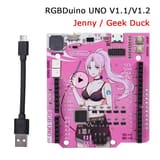Search Results
8/10/2025, 2:22:41 PM
>>106208454
Arduino is open hardware, meaning the schematics are freely available. As a result, chink clones are practically identical to genuine ones (the genuine ones have some silver marking but that's just aesthetics).
So yeah, they can do the same as a genuine one, but cost a lot less.
That being said, arduino uno clones (the one you posted) are a bit outdated at this point, the only upside they really have is that they have the female headers which makes it easier for prototyping when you're an absolute beginner.
Instead you can get arduino nano clones, which are smaller, cheaper, use usb-c or micro-usb and have the same power. A compromise you can make is buy a cheap uno clone for prototyping and if you ever want to make a project out of it that's more permanent, use a micro clone instead. The code transfers 1:1.
The other anon >>106208956 who mentioned esp means esp32 based boards, which use a different chipset. As a beginner, they work basically the same, just one different setting in the programming software, except esp32s are usually higher powered. Doesn't matter for most applications, but for those it does matter it's a big difference.
More importantly, if you look up "esp8266" you find boards that have a built-in wifi antenna and support for it, which is really nice if you want any IOT functionality, with an arduino it has to either be a connected input device, or sending data via serial port.
If you just want to get one, get a esp8266 board and be done with it. If you like the easier headers on the uno, get a cheap clone. (Picrel is not the cheapest option, but gives streetcred)
As for other things you'll want to order with it, so you can actually do some prototyping:
A breadboard, male-male (not optional) and male-female (optional) jumper wires are a must.
Stuff that you don't need, but probably won't regret having:
multimeter, soldering iron, wire strippers, spare wire, push buttons
The rest depends on the projects/things you want to build.
Arduino is open hardware, meaning the schematics are freely available. As a result, chink clones are practically identical to genuine ones (the genuine ones have some silver marking but that's just aesthetics).
So yeah, they can do the same as a genuine one, but cost a lot less.
That being said, arduino uno clones (the one you posted) are a bit outdated at this point, the only upside they really have is that they have the female headers which makes it easier for prototyping when you're an absolute beginner.
Instead you can get arduino nano clones, which are smaller, cheaper, use usb-c or micro-usb and have the same power. A compromise you can make is buy a cheap uno clone for prototyping and if you ever want to make a project out of it that's more permanent, use a micro clone instead. The code transfers 1:1.
The other anon >>106208956 who mentioned esp means esp32 based boards, which use a different chipset. As a beginner, they work basically the same, just one different setting in the programming software, except esp32s are usually higher powered. Doesn't matter for most applications, but for those it does matter it's a big difference.
More importantly, if you look up "esp8266" you find boards that have a built-in wifi antenna and support for it, which is really nice if you want any IOT functionality, with an arduino it has to either be a connected input device, or sending data via serial port.
If you just want to get one, get a esp8266 board and be done with it. If you like the easier headers on the uno, get a cheap clone. (Picrel is not the cheapest option, but gives streetcred)
As for other things you'll want to order with it, so you can actually do some prototyping:
A breadboard, male-male (not optional) and male-female (optional) jumper wires are a must.
Stuff that you don't need, but probably won't regret having:
multimeter, soldering iron, wire strippers, spare wire, push buttons
The rest depends on the projects/things you want to build.
Page 1
